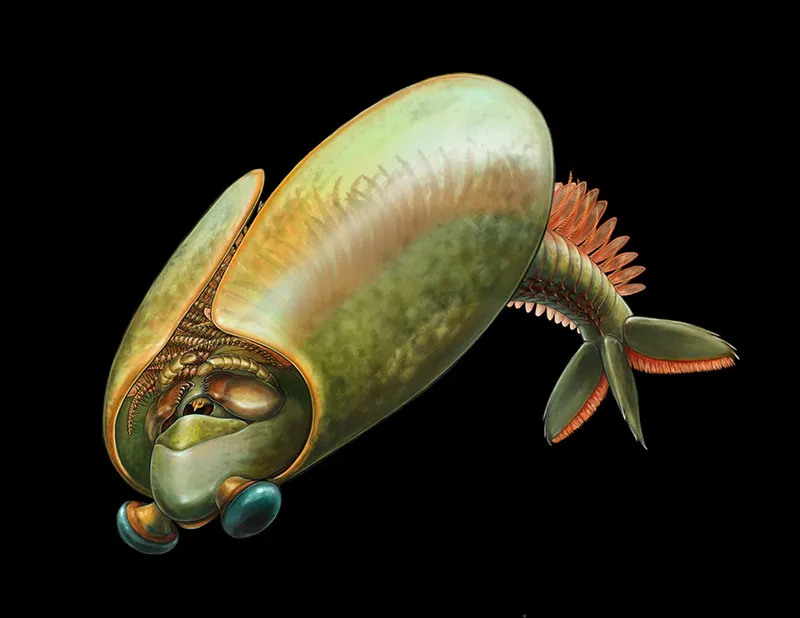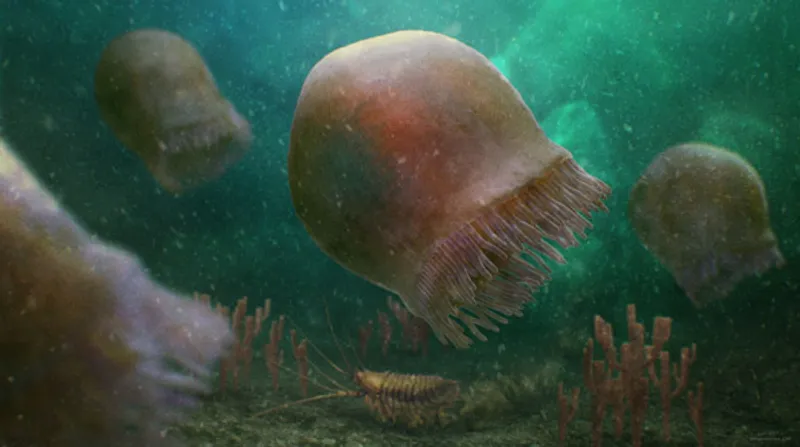Published on JUL 11 2023 by David McKay, ROM Senior Publicist
Canada’s Crawford Lake Selected as Top World Site to Define Start of Proposed Anthropocene Epoch

An international group of researchers has selected Crawford Lake in Milton, Ont., as the site that could formally define the start of the Anthropocene, a proposed new epoch shaped by the significant global impacts of recent human activity.
On July 11, 2023, the Anthropocene Working Group (AWG) announced that out of 12 sites in consideration worldwide, Crawford Lake was voted to be the most suitable location for the proposed ‘golden spike,’ a global reference point in the Earth’s stratigraphic record indicating the start of a new geological unit of time.
Under the leadership of project Principal Investigators, Brock University Professors of Earth Sciences Francine McCarthy and Martin Head, and Earth Sciences Professor Tim Patterson from Carleton University, a multi-institutional team of experts, based mainly in Canada, has been studying well-preserved annually laminated sediment found on the bottom of this deep lake to uncover clear evidence of the ‘Great Acceleration,’ a period of intense resource use, population growth and environmental impact in the mid-20th century.
The AWG, which falls under the International Commission on Stratigraphy, has identified evidence of a tipping point in Earth systems at this period in history, with conditions very different from the Holocene Epoch that began nearly 12,000 years ago, at the end of the last ice age.
The AWG will present its proposal to the Subcommission on Quaternary Stratigraphy followed by the International Commission on Stratigraphy, suggesting that the Holocene Epoch has come to an end, and proposing the Crawfordian as the first age of the Anthropocene epoch. If the proposal receives a supermajority in votes by both bodies, and by the International Union for Geological Sciences, the Anthropocene will be ratified as our latest epoch and Crawford Lake will become one of more than 70 ‘golden spike’ sites recognized around the world to define boundary points in geological time.
“Conservation Halton acquired Crawford Lake in the 1960s, and the site has been contributing to local and international research efforts ever since then,” said Hassaan Basit, President and CEO of Conservation Halton. “In the 1970s, corn pollen grains detected in the lake’s sediment led to the archaeological discovery of a 600-year-old Indigenous village, which we teach visitors about today in our reconstructed longhouses. Now, the latest geological findings add a macro, planetary perspective to the stories told at Crawford Lake. These local and global narratives are of incredible importance — they shape our understanding of the past, connect us in the present, and frame possibilities for the future.”
McCarthy and Patterson, along with an interdisciplinary team of researchers from Queen’s University, the Canadian Museum of Nature, the Royal Ontario Museum, and other university and government institutions, led three sediment sampling projects at Crawford Lake between 2019 and 2023.
With well-preserved layers in the bottom of the lake that can be read like tree rings, laboratory analysis of the lake’s sediment cores revealed a mid-20th century “plutonium fallout signal” related to nuclear weapons testing that occurred in the Pacific Ocean from the 1950s through 1963, consistent with other samples collected worldwide. This plutonium signature coincides with the ‘Great Acceleration’ and is the primary marker proposed to identify the start of the Anthropocene epoch.
Additional biological and environmental indicators found in the cores, including microscopic diatoms and chrysophtyes as well as chemical markers, show evidence of large-scale changes in Earth’s atmosphere and other systems since 1950, supporting the lake as the candidate site to define the start of the proposed Anthropocene. The scientific results were published in The Anthropocene Review (Volume 10, Issue 1, 2023).
“Crawford Lake is an exceptional site for scientific research,” said McCarthy. “The lake’s rare meromictic qualities prevent layers of water from mixing. In turn, the deep, cool, undisturbed waters above the lakebed help to preserve annually resolvable sediment deposits that we can carefully extract, using freeze-core methods, and analyze to pinpoint geological changes in time and history.”
“I am honoured to have been entrusted to work with the Indigenous caretakers of Crawford Lake and with such a great group of top-notch researchers on this historic project,” said Patterson. “I am proud that my lab’s expertise in collecting and analyzing freeze cores was able to play a central role in this project. Students in my group analyzed the superbly preserved annually deposited layers in the Crawford Lake sedimentary record to establish the critical yearly chronology, and to document yearly changes in lake productivity and paleoclimatic influences on sedimentary deposition. This permitted us to clearly illustrate the story of the Anthropocene epoch archived in the lake.”
Whether or not the Anthropocene is ratified as the official current epoch, sediment cores and research collections from Crawford Lake will be curated for scientific research in the permanent collections of the Canadian Museum of Nature and the Royal Ontario Museum to preserve this significant natural record of human impact and planetary change.
Quotes
“Including the Anthropocene formally in the geological time scale sends a clear message about the huge planetary shift that occurred in the mid-20th century: increases in population, carbon dioxide, and all sorts of other climate drivers, aided enormously by advances in technology. These changes are ongoing. They threaten our future. Obstructing formalization might be seen as a denial of these critical changes.”
- Martin Head, Professor of Earth Sciences, Brock University and Vice-Chair, ICS Subcommission on Quaternary Stratigraphy
“If a GSSP is chosen, the Anthropocene would move from an undefined period used in popular culture and by many scientists, to a formal geological epoch. This would recognize a fundamental reality — humans have changed the Earth to such an extent that it’s traceable in the geological record. If successful, the GSSP designation will speak to the efforts of Team Crawford, and we hope it will promote on a global scale the ongoing magnitude of human activities on our planet, resulting in a new urgency for positive change.”
- Brian Cumming, Professor and Head (Biology), Queen’s University and Co-director of the Paleoecological Environmental Assessment and Research Lab (PEARL)
“Crawford Lake is a storyteller. She collects information from our atmosphere, telling local and global stories of our past. What we know about the teaching village at Crawford Lake and the proposed Anthropocene comes directly from our special little lake, and we are so thankful for her.”
- Brad Howie, Indigenous Education Coordinator, Conservation Halton
“The Crawford Lake research project has demonstrated critical evidence of local, regional and global human impacts to the lake’s environment over time. The Canadian Museum of Nature is proud to collaborate with its partners to ensure the story of this tiny lake continues to be a touchpoint in understanding the importance of the Anthropocene.”
- Danika Goosney, Ph.D., President and CEO, Canadian Museum of Nature
“If museum objects are stories, then the Crawford Lake sediment cores are epics — hundreds of years of geological change, written in earth and frozen in time. But they are also, more simply, a poignant reminder of humanity’s profound impact on our planet.”
- Josh Basseches, Director and CEO, Royal Ontario Museum
“The Earth has always preserved (though not always perfectly) its evolution and changing nature of its inhabitants in the global stratigraphic record. Special sites like Crawford Lake show that this process has continued right up to the present, allowing the science of geology to rub shoulders with history and environmental monitoring. It is common for lake sediments to contain a record of historical environmental change, what is exquisite in lakes like Crawford Lake is the annually layered sediments that form such a precise record of past changes.”
- Simon Turner, Ph.D., Honorary Senior Research Associate, University College London and Secretary, Anthropocene Working Group of the ICS Subcommission on Quaternary Stratigraphy
About Crawford Lake Crawford Lake Conservation Area, one of Conservation Halton’s eight parks, forms part of the Niagara Escarpment UNESCO World Biosphere Reserve. The first major finding revealed by Crawford Lake’s sediment record was corn pollen dating from the 13th to 15th centuries. This led to the discovery of the archaeological remains of a pre-colonial Wendat or Attawandaron village nearby. Three longhouses from this village have been reconstructed on their original footprint to help educate the public about the area’s Indigenous history through programs, exhibits, gardens, and workshops developed with Indigenous partners. The park also preserves significant wetlands, ancient cedars, and species-at-risk habitats in addition to providing valuable greenspace and 18 kilometres of hiking trails for the surrounding community.
Read the original press release
Written by David McKay, ROM Senior Publicist
← Home
